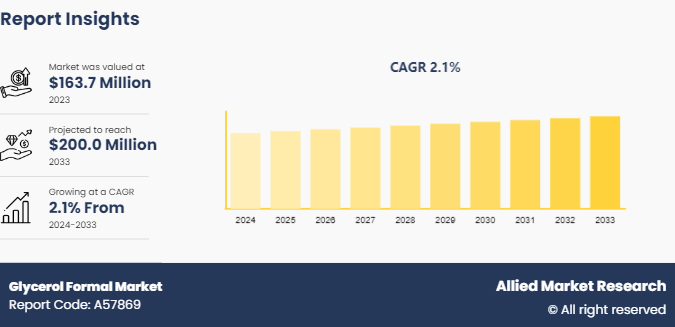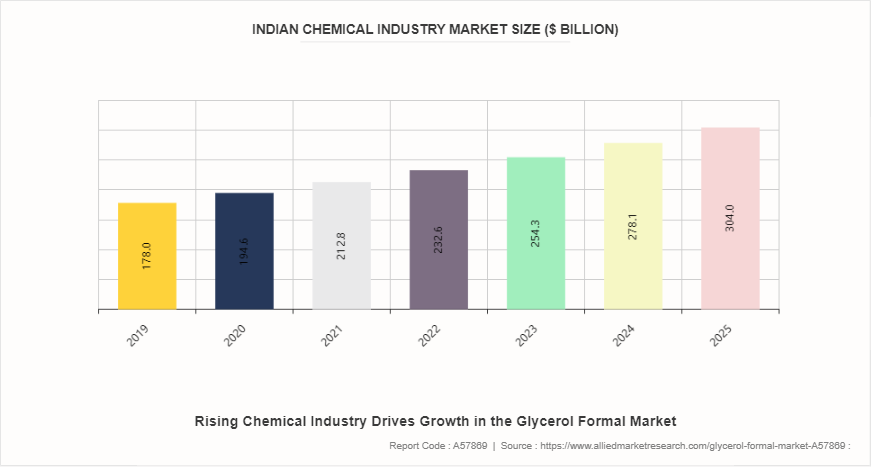Glycerol Formal Market Research, 2033
The global glycerol formal market was valued at $163.7 million in 2023, and is projected to reach $200.0 million by 2033, growing at a CAGR of 2.1% from 2024 to 2033.

Market Introduction and Definition
Glycerol formal is a chemical compound derived from the reaction of glycerol and formaldehyde. It is also recognized as formal glycerol or 1, 3-Dioxolan-2-one-4-methanol. It is a cyclic acetal compound formed by the condensation of glycerol, a triol alcohol and formaldehyde, a simple aldehyde. Glycerol formal has numerous characteristics that make it recommended for utilization in resins, adhesives, coatings, and as a solvent for pigments and dyes in sectors together with plastics, textiles, and coatings. It is especially used in many industrial processes, mostly as a solvent, an intermediate in chemical synthesis, and in the production of polymers. Glycerol formal exhibits remarkable resistance to heat, ozone, and weathering, distinguishing it as a high-performance elastomer. The unique characteristics positions glycerol formal as a reliable material for seals, gaskets, hoses, and other components in industries such as automotive, construction, and manufacturing.
Key Takeaways
- The glycerol formal market study covers 20 countries. The research includes a segment analysis of each country in terms of value ($million) and volume for the projected period.
- More than 1, 500 product literatures, industry releases, annual reports, and other such documents of major glycerol formal industry participants along with authentic industry journals, trade associations' releases, and government websites have been reviewed for generating high-value industry insights.
- The study integrated high-quality data, professional opinions and analysis, and critical independent perspectives. The research approach is intended to provide a balanced view of global markets and to assist stakeholders in making educated decisions to achieve their most ambitious growth objectives.
Key Market Dynamics
The growing demand within the coatings and paints enterprise significantly propels the market demand for glycerol formal, an integral compound recognized for its solvent properties and numerous chemical applications. Glycerol formal's special attributes, including its solvency, stability, and compatibility with various chemical formulations, make it a desirable preference for use in coatings and paints. The demand for environment-friendly solvents and functional additives has intensified as the coatings and paints region experiences excellent expansion, driven by the aid of factors such as urbanization, infrastructure development, and multiplied building activities globally. The glycerol formal market experiences growth propelled by expanding applications in the chemical and pharmaceutical sectors. Glycerol formal finds extensive use as a solvent and intermediate in chemical synthesis processes. Moreover, its role in pharmaceutical formulations as a stabilizer and solvent further boosts market demand. Glycerol formal emerges as a versatile compound, driving its market growth steadily with increasing research and development activities in these industries.
Regulatory compliance and safety concerns are significant obstacles impeding glycerol formal market growth. Stringent regulations govern its handling, storage, and usage due to its chemical nature. Safety risks associated with improper handling necessitate stringent protocols and employee training. Environmental challenges and sustainability issues, alongside regulatory and safety hurdles, collectively hamper market expansion. Addressing these concerns is essential to foster market growth and ensure safe and sustainable glycerol formal usage. The rise in demand for biodegradable polymers presents a significant opportunity for the glycerol formal market. Glycerol formal, a key ingredient in the production of biodegradable polymers, stands to benefit from the growing emphasis on environmentally friendly materials. As industries seek sustainable alternatives to traditional plastics, the demand for glycerol formal is expected to increase, driving market growth and expansion into new applications across various sectors.
Market Segmentation
The global glycerol formal market is segmented into purity level, application, end use industry, and region. By purity level, the market is classified as 99% purity and 95% purity. By application, the market is categorized into coatings, adhesives, resins, and others. By end use industry, the market is segmented into food & beverage, pharmaceutical & nutraceuticals, personal care & cosmetic, and others. Region-wise the market is analyzed across North America, Europe, Asia-Pacific, and LAMEA.
Competitive Landscape
The key market players operating in the glycerol formal market include Emery Oleochemicals, Oleon NV, Kao Corporation, Ecogreen Oleochemicals, Procter & Gamble Chemicals, Musim Mas Group, Wilmar International Ltd., Croda International and McGean. Other players in the glycerol formal market include SimSon Pharma Limited, Glentham Life Sciences Limited, Anmol Chemicals, Muby Chemicals, and others.
Regional Market Outlook
In the Asia-Pacific, the glycerol formal market is propelled by the expansion of chemical and pharmaceutical sectors. In addition, increase in demand for paints and coatings, attributed to infrastructural development and industrial growth, further boosts the market growth. Glycerol formal's versatile applications in these sectors, including pharmaceutical formulations and as a solvent in paints and coatings, drive its demand, solidifying its position in these regions.
- According to India Brand Equity Foundation (IBEF) , India is the sixth largest producer of chemicals in the world and third in Asia, contributing 7% to India’s GDP. India's chemical sector, which is currently estimated to be worth US$220 billion in 2022 and is anticipated to grow to US$300 billion by 2025 and US$1 trillion by 2040.
- According to Invest India, market size of India pharmaceuticals industry is expected to reach $65 billion by 2024, $130 billion by 2030 and $450 billion market by 2047. India is a major exporter of Pharmaceuticals, with over 200+ countries served by Indian pharma exports. India supplies over 50% of Africa’s requirement for generics, 40% of generic demand in the U.S. and 25% of all medicine in the UK.
- According to the Information Technology & Innovation Foundation, China is the largest chemicals market in the world, giving Chinese producers a key advantage in their home market. In 2022, China accounted for 44% of global chemical production and 46% of capital investment.
- According to the India Brand Equity Foundation, the Indian pharmaceutical industry is worth approximately $50 billion with over $25 billion of the value coming from exports. About 20% of the global exports in generic drugs are met by India.
Indian Chemical Industry Overview

The steady growth in the chemical industry, with its market size expanding from $178 billion in 2019 to an estimated $304 billion by 2025, significantly impacts the glycerol formal market. As the chemical sector flourishes, demand for glycerol formal used as a solvent, in pharmaceuticals, and as an intermediate in chemical reactions rises correspondingly. This expansion supports increased production capacities, innovation in applications, and broader adoption across various industries. The burgeoning chemical market creates a favorable environment for glycerol formal, driving its market growth and opening new opportunities for its use in emerging sectors and advanced technologies.
Industry Trends
- According to the Canadian government, pharmaceutical sales in Canada have a 2.2% share of the global market, making Canada the eighth largest world market. From 2018 to 2022, pharmaceutical exports and imports between Canada and the rest of the world increased by 38% and 55% respectively. In 2022, total Canadian pharmaceutical domestic export from 2013 to 2022 accounted for $12.8 billion and import accounts for $30.2 billion.
- Glycerol formal has gained attention as a green solvent in various industries, including pharmaceuticals, coatings, and cosmetics. Its eco-friendly nature, low toxicity, and ability to dissolve a wide range of compounds make it a promising alternative to traditional solvents like methanol or acetone.
- As per the report published by India Brand Equity Foundation in July 2023, according to the leading paint manufacturer Akzo Nobel India, India's paints and coatings industry is expected to reach US$12.22 billion (Rs. 1 lakh crore) in the next five years. The company stated in its most recent annual report that the paint and coatings industry is currently valued at about US$7.57 billion (Rs. 62, 000 crore) . The company claimed that during the fiscal year 2022-2023, the prices of raw materials decreased from their prior highs, which was a favorable development for the paints and coatings industry.
Key Sources Referred
- Invest India
- American Coatings Association
- India Brand Equity Foundation
- Home Improvement Research Institute
- British Coatings Federation
- Indian Speciality Chemical Manufacturer’ Association (ISCMA)
- Information Technology & Innovation Foundation
Key Benefits For Stakeholders
- This report provides a quantitative analysis of the market segments, current trends, estimations, and dynamics of the glycerol formal market analysisto identify the prevailing market opportunities.
- The market research is offered along with information related to key drivers, restraints, and opportunities.
- Porter's five forces analysis highlights the potency of buyers and suppliers to enable stakeholders make profit-oriented business decisions and strengthen their supplier-buyer network.
- In-depth analysis of the glycerol formal market segmentation assists to determine the prevailing market opportunities.
- Major countries in each region are mapped according to their revenue contribution to the global market.
- Market player positioning facilitates benchmarking and provides a clear understanding of the present position of the market players.
- The report includes the analysis of the regional as well as global glycerol formal market trends, key players, market segments, application areas, and market growth strategies.
Glycerol Formal Market Report Highlights
| Aspects | Details |
| Market Size By 2033 | USD 200.0 Million |
| Growth Rate | CAGR of 2.1% |
| Forecast period | 2024 - 2033 |
| Report Pages | 340 |
| By Purity Level |
|
| By Application |
|
| By End-Use Industry |
|
| By Region |
|
| Key Market Players | Procter & Gamble Chemicals, Emery Oleochemicals, Wilmar International Ltd., Croda International, Ecogreen Oleochemicals, Kao Corporation, Musim Mas Group, McGean, Lambiotte & Cie, Oleon NV |
Loading Table Of Content...



